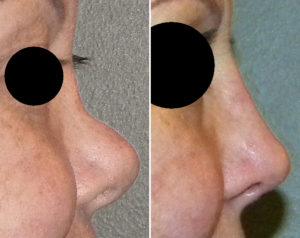Removal or smoothing out a hump or bump on a nose is one of the most common techniques used in rhinoplasty. Many patients have a prominent hump that they want reduced. Hump reduction is a combination of bone and cartilage removal. Small or minor humps are usually filed done which is a very controlled surgical technique in which it is difficult to overdo it. Large humps on the nose require more aggressive techniques (a chisel) because more bone and cartilage need to be removed to bring down its height. Such aggressive techniques, however, have the pot7ential to take too much off. If too much is taken off your nasal hump, however, it will look scooped out creating a ‘ski slope’ nose appearance or a slightly sunken in appearance. Sometimes this look is not evident for months or longer….other times it may be apparent right from the beginning.

Rebuilding with cartilage is always superior to a synthetic implant. The use of synthetic materials is certainly easier and makes for a more rapid operation but the thin skin on the bridge of the nose in some patients makes its use risky. Synthetic implants are more prone to infection and its edges or outline may ultimately be capable of being felt or even seen. I would not say I would never use an implant on the bridge of the nose alone but the patient would need to have fairly thick skin over it to consider it.
In patients with very thin skin, even cartilage grafts alone may be problematic. The cartilage graft can be crushed to make its edges softer but this makes control of the shape of the graft more difficult. In these cases, I like the use of Alloderm, which is processed human dermis (skin with the top layer removed) that comes out of a box. While reconstituted with water, it is a soft flexible sheet which can be easily cut and used to provide additional covering of the cartilage graft. Alloderm placed between the skin and the cartilage essentially thickens the overlying skin and helps camouflage the graft. In some cases, Alloderm may be used alone in multiple layers to do the rebuilding. Besides the fact that Alloderm can be cut into any shape and is soft, it will become part of the underside of the skin and is incorporated into your natural tissue. This is why it is better than a synthetic implant which never does that and poses a lifelong risk of potential problems.
Rebuilding the bridge of the nose is fairly straightforward to do and usually results in a very satisfactory outcome. So if your initial rhinoplasty resulted in this problem, rest assured there is a good solution.
Dr. Barry Eppley
Indianapolis, Indiana


